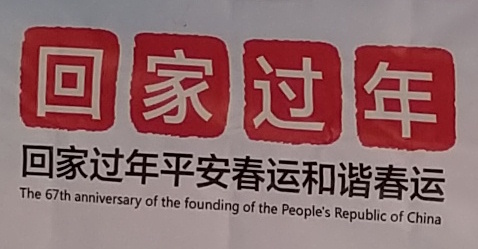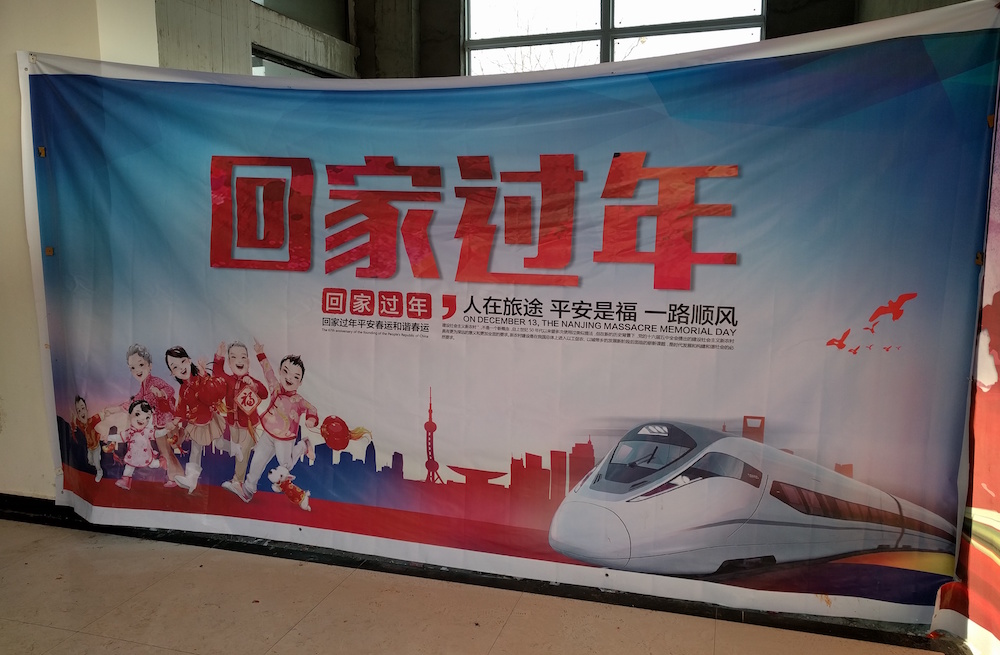New Year's massacre
« previous post | next post »
Boris Kootzenko spotted this truly bizarre banner at a service area on the highway leading west from Shanghai in Anhui Province:
The theme of the poster is "huíjiā guònián 回家过年" ("returning home to celebrate the New Year"). That phrase is written in very large red characters across the center of the upper half of the banner. For some unknown reason, it is then repeated in smaller white characters inside red squares, followed by an apostrophe, or perhaps that's a stray closing single quotation mark that is missing its matching opening quotation mark.
The twelve medium sized black characters in three groups beneath the right side of the huge red characters wish travellers a safe and smooth journey, which is perfectly normal, but the twelve smaller characters beneath the four white characters in red blocks to the left consist of one more iteration of "huíjiā guònián 回家过年" ("returning home to celebrate the New Year") and a wish for safe and "harmonious" (that's a code word left over from the time of President Hu Jintao) spring festival transport (chūnyùn 春运), the latter expression clumsily repeated in close succession.

The very small English wording ("The 67th anniversary of the founding of the People's Republic of China") beneath the twelve characters just discussed have nothing to do with the Chinese text and are completely irrelevant to the New Year celebration.
The three lines of small characters on the bottom right contain a lot of blather about the construction of a new socialist countryside, and are also unrelated to the spring festival and travelling home to celebrate the New Year.
But the most utterly bewildering and preposterous words on the banner are these: "ON DECEMBER 13, THE NANJING MASSACRE MEMORIAL DAY".
That is completely inappropriate in the context of the festive atmosphere surrounding the celebration of the New Year. The only conceivable explanation I can come up with for how it happened is that they recycled some old English text they had lying around, thinking, "Hey, we ought to have something for the wāiguǒrén 歪果仁 ('crooked nuts') — a bad pun for wàiguórén 外國人 ('foreigners) — who don't know any Chinese, so we might as well educate them while we're at it. Since our Chinese compatriots don't know English, they won't care what those funny letters say anyway."
Whatever the reason for these blunders, the local propaganda office needs a new poster maker.
[Thanks to Fangyi Cheng and Yixue Yang]


Alan Shaw said,
February 9, 2017 @ 2:33 pm
It's a comma.
KeithB said,
February 9, 2017 @ 3:29 pm
There has to be a Bowling Green joke in here somewhere, but I can't find it.
(On a more somber note, if you ever get a chance visit the memorial for the victims of the Nanjing massacre. It is incredibly moving.)
Jenny Chu said,
February 9, 2017 @ 6:57 pm
Should I make anything of the fact that the people in the image appear to be fleeing from the path of the onrushing train? What is the underlying message here?
Victor Mair said,
February 9, 2017 @ 7:35 pm
If it's a comma, what's it for? What's it dividing? And why isn't it at the bottom of a line instead of hanging between the top of two lines?
FM said,
February 9, 2017 @ 8:13 pm
I'm with Jenny Chu. I thought the post was going to be about the terrified family fleeing from an already blood-drenched bullet train.
dai huteng said,
February 9, 2017 @ 11:30 pm
maybe the typewriter is not good at English. This guy stolen the sentence from somewhere.
Josh said,
February 10, 2017 @ 2:03 am
Seems like it came from this PSD template: http://weili.ooopic.com/weili_16046947.html
Whoever edited it must have kept the English text.
How a blurb about the Nanjing Massacre ended up in a PSD template for a banner wishing 平安春运,回家过年 — I have no idea.
If you Google Image Search the headline in the original photo, you get a couple variations of the same poster template, many with that out-of-place comma/single quote.
cliff arroyo said,
February 10, 2017 @ 1:08 pm
I'm pretty sure the English is there entirely for decorative purposes and the people who put it there could not care less what the information content is…
Graeme said,
February 14, 2017 @ 6:37 am
I like the way the city skyline blueshifts. #wavelengths